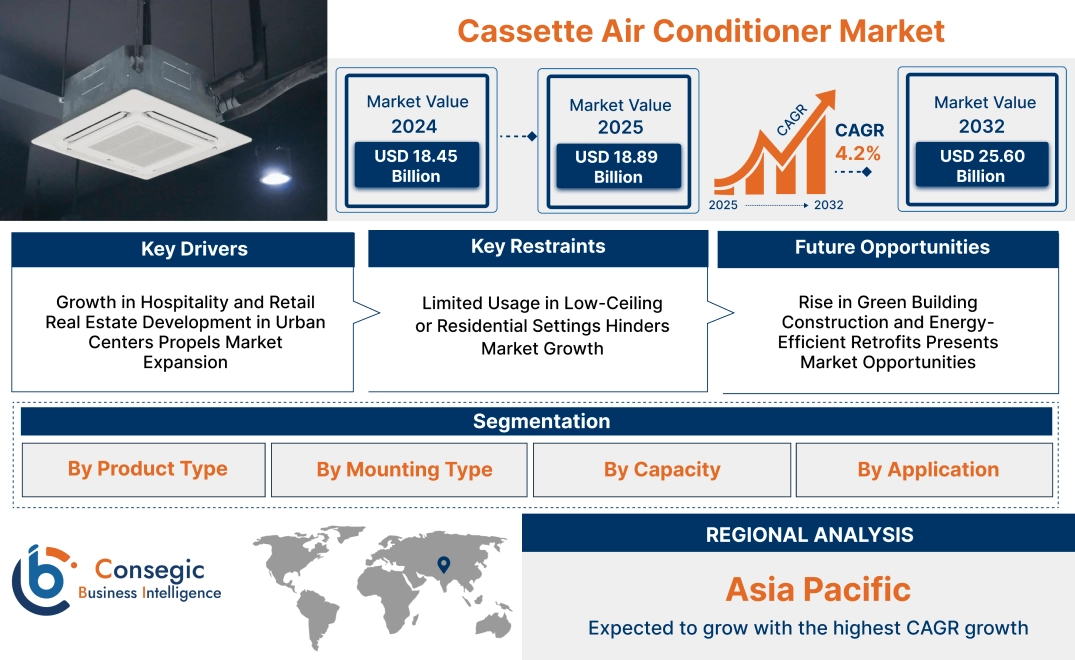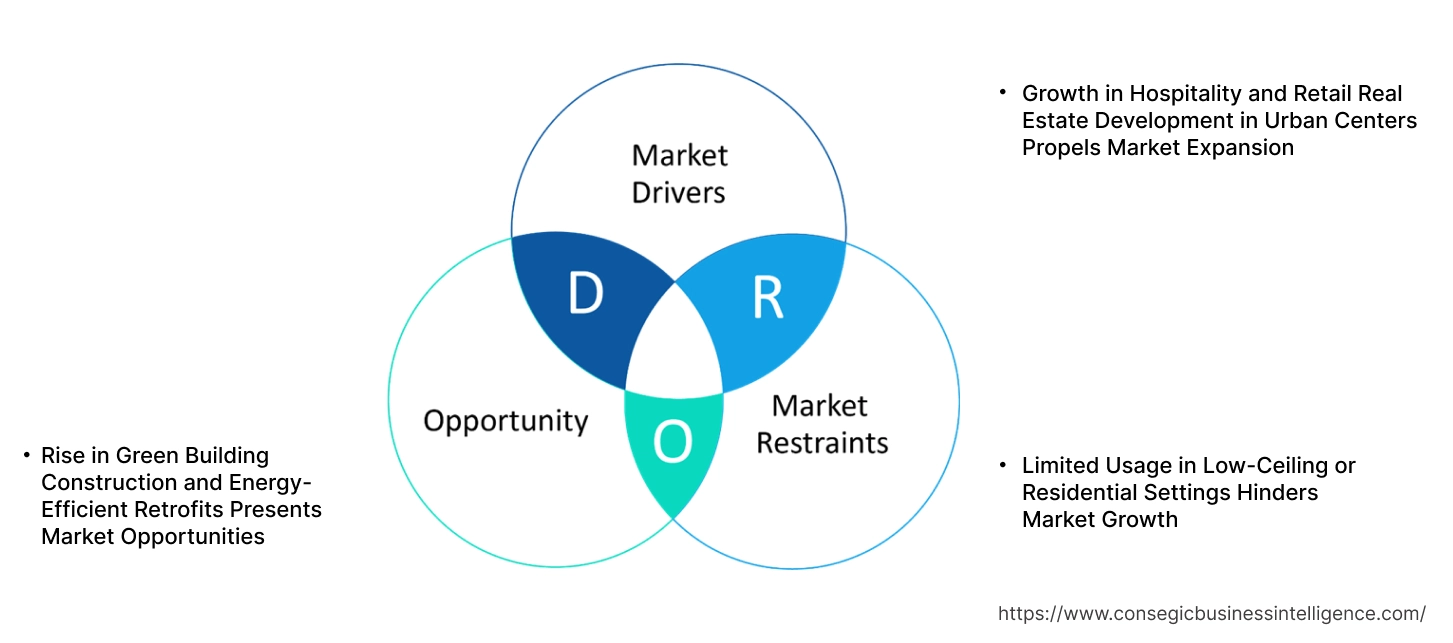- Summary
- Table Of Content
- Methodology
Cassette Air Conditioner Market Size:
Cassette Air Conditioner Market size is estimated to reach over USD 25.60 Billion by 2032 from a value of USD 18.45 Billion in 2024 and is projected to grow by USD 18.89 Billion in 2025, growing at a CAGR of 4.2% from 2025 to 2032.
Cassette Air Conditioner Market Scope & Overview:
The cassette air conditioner is a ceiling-installed HVAC unit meant to circulate conditioned air evenly throughout indoor areas via four-way airflow discharge. It is widely used in offices, retail stores, restaurants, and residential structures where floor and wall space is limited.
This unit combines a hidden indoor system with an outdoor compressor and features remote control operation, programmable timers, air purification filters, and energy-saving modes. Its construction allows for even cooling or heating, minimum visual intrusion, and silent operation.
The major benefits are maximized air circulation, compact installation in small spaces, and increased climate control for big and medium rooms. Cassette air conditioner provides zoning capability that enables individual temperature control for more comfortable occupants. Its low-visibility installation with ceiling tiles and support for false ceilings are factors making it the best option in today's design-driven interiors, concentrating on looks as well as effectiveness in climate regulation.
Key Drivers:
Growth in Hospitality and Retail Real Estate Development in Urban Centers Propels Market Expansion
Accelerating urbanization and the development of retail and hospitality infrastructure in urban cities are driving growth of cassette air conditioners' adoption. Such systems are hugely sought after across hotels, restaurants, and luxury retail outlets for their minimalist aesthetic appeal, reduced noise levels, and even flow distribution of conditioned air. Real estate developers and architects appreciate cassette units for ensuring ceiling aesthetics without compromising on providing zonal air-conditioning of lobbies, bedrooms, and shopping spaces. With increased tourism, enhanced commercial leasing activity, and rising consumer expenditure, demand for designer-integrated and space-effective cooling systems is increasing. The Asia-Pacific, Middle East, and some city centers in Europe are experiencing focused retail and hospitality developments, further propelling product adoption. The rising convergence of commercial interior design with integration of HVAC systems is fueling long-term cassette air conditioner market expansion.
Key Restraints:
Limited Usage in Low-Ceiling or Residential Settings Hinders Market Growth
Cassette air conditioners need sufficient ceiling height and plenum space to operate best and distribute airflow. Under low-ceiling spaces—usually less than 2.7 meters—airflow patterns become ineffective, and direct cold drafts create occupant discomfort. Such restrictions limit application in small apartments, low-rise buildings, and economy offices where ceiling clearance and structural access are limited. Furthermore, the requirement for false ceilings and supporting infrastructure increases complexity and cost in residential retrofits. Consequently, end-users in limited architectural spaces favor floor-standing or wall-mounted systems that provide easier installation and improved space compatibility. Even with increased demand for effective cooling, such design limitations limit deployment flexibility. These architectural limitations are a major constraint to mass adoption, especially in new residential markets, thus limiting the cassette air conditioner market growth.
Future Opportunities:
Rise in Green Building Construction and Energy-Efficient Retrofits Presents Market Opportunities
The international emphasis on sustainable building is fueling demand for energy-efficient HVAC technologies that qualify for green building ratings like LEED, BREEAM, and WELL. Inverter-driven cassette air conditioners with low-GWP refrigerants and advanced airflow sensors deliver high seasonal energy efficiency and facilitate smart zoning and occupant comfort. Their application in retrofit schemes aimed at delivering energy savings in commercial buildings is growing, particularly in mixed-use developments and institutional buildings. Developers and building management are focusing on systems with lower duct losses and low maintenance in energy retrofit programs. Furthermore, motion-sensing and IoT-responsive models enable requirement-based operation, which supports lower operational energy consumption. This integration with building energy performance objectives and decarbonization initiatives is facilitating new opportunities for cassette units in developed economies.
- For instance, in March 2025, Samsung unveiled its plans to expand global HVAC reach with custom B2B climate solutions, which include innovative heat pump technology such as WindFree™ 1-Way cassette air conditioner and increased IoT connectivity, where SmartThings Pro is able to remotely analyze air conditioners and other connected devices to ensure energy savings, optimized climate control and maintenance support.
These trends are creating long-term the cassette air conditioner market opportunities fueled by both requirement and sustainable HVAC integration growth.
Cassette Air Conditioner Market Segmental Analysis :
By Product Type:
Based on product type, the cassette air conditioner market is segmented into single-way cassette, two-way cassette, four-way cassette, and others including eight-way cassette units.
The four-way cassette segment held the largest cassette air conditioner market share of 60.4% in 2024.
- Four-way cassettes deliver uniform airflow in four directions, making them ideal for large commercial and office spaces requiring consistent cooling coverage.
- These units are preferred for their compact ceiling-mounted design, efficient space utilization, and unobtrusive appearance.
- As per the segmental analysis, technological trends such as smart control systems and energy-efficient inverters are significantly enhancing four-way cassette adoption.
- For instance, in July 2024, Samsung India launched a new range of ACs featuring WindFree™ and 360 Degree Bladeless Technology in chilled water-based cassette units for indoor use. The new units are available in three variants, including 4 Way Cassette (6.0KW~10.0KW), 1 Way Cassette (2.6KW~4.2KW) and 360o Chilled Water Cassette (6.0KW~10.0KW).
- Rising need for energy-efficient air distribution solutions in commercial buildings further drives the cassette air conditioner market demand in this segment.
The two-way cassette segment is projected to witness the fastest CAGR over the forecast period.
- Two-way cassettes provide bidirectional air discharge and are ideal for long rectangular rooms and narrow spaces, improving layout-specific air distribution.
- These systems are increasingly used in modern interiors due to their sleek ceiling integration and minimal noise performance.
- According to market trends, commercial renovation and interior-focused designs are favoring increased installation of two-way cassettes.
- Manufacturers are also introducing models with automatic swing and motion-sensing features, accelerating the cassette air conditioner market growth.
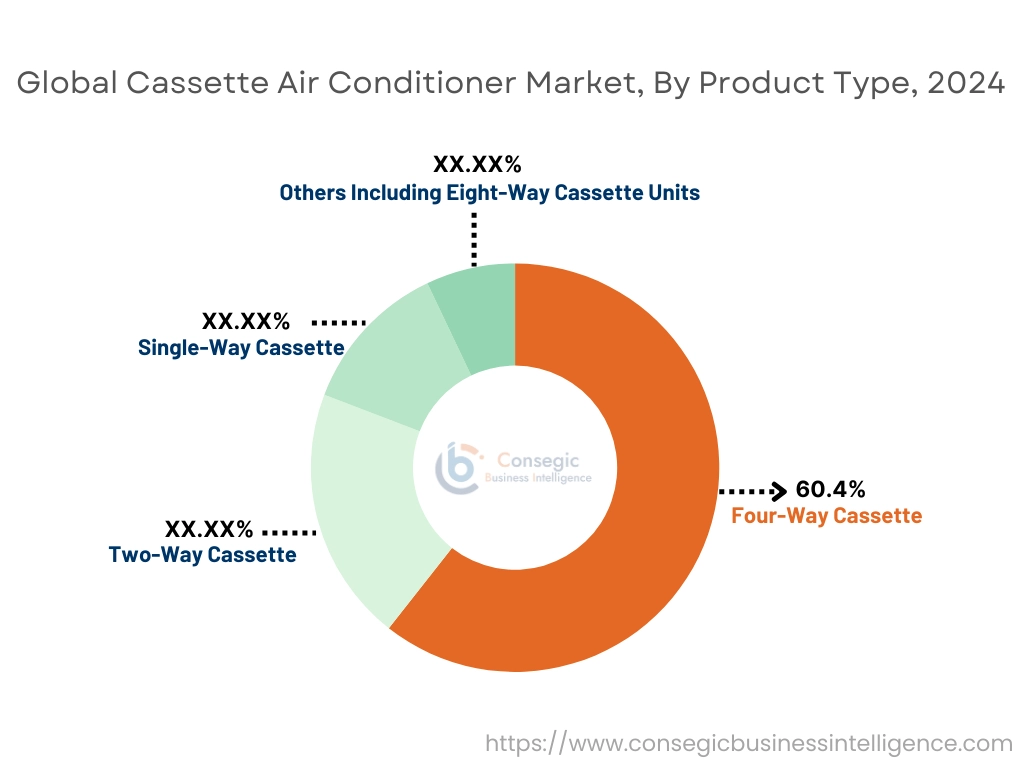
By Mounting Type:
Based on mounting type, the market is categorized into ceiling-mounted, suspended-mounted, and concealed ducted cassette units.
The ceiling-mounted segment dominated the market share in 2024.
- Ceiling-mounted units are widely adopted due to their aesthetic appeal and suitability for high-traffic areas like offices, hotels, and retail spaces.
- This configuration allows better air coverage and eliminates floor or wall clutter, improving interior design flexibility.
- As per cassette air conditioner market trends, advancements in noise reduction and smart controls are enhancing the functionality of ceiling-mounted units.
- Additionally, rising deployment in large-scale commercial infrastructure is driving market demand.
The concealed ducted cassette unit segment is anticipated to expand at the highest CAGR during the forecast period.
- These systems are designed to be hidden within the ceiling, offering superior interior aesthetics and quieter operation compared to exposed units.
- They allow centralized cooling with minimal visual impact, which is a major advantage in high-end commercial or hospitality applications.
- Technological innovations in airflow optimization and compact form factors are supporting the cassette air conditioner market expansion in this category.
- Adoption is rising in premium office buildings and upscale hotels, aligning with trends in customized and discreet air conditioning solutions.
By Capacity:
By capacity, the cassette air conditioner market is divided into up to 3 tons, 3–5 tons, and above 5 tons.
The 3–5 tons segment held the major cassette air conditioner market share in 2024.
- Systems within this capacity range are suitable for medium-to-large commercial areas such as conference rooms, small shopping outlets, and open workspaces.
- They offer optimal energy usage and balance between airflow and coverage, aligning with the needs of cost-sensitive commercial operators.
- As per the cassette air conditioner market analysis, the adoption of 3–5 ton units is rising in new construction and retrofit projects in urban zones.
- Increased commercial demand from emerging markets in Asia-Pacific is contributing significantly to this segment’s dominance.
The above 5 tons segment is expected to register the fastest CAGR.
- This segment is preferred for large open halls, manufacturing floors, and institutional auditoriums that require high-capacity cooling systems.
- The rise in large-format retail spaces and convention centers is creating favorable conditions for segment growth.
- Trends in modular HVAC system integration and improved compressor technologies are contributing to the efficiency of large-capacity cassettes.
- The cassette air conditioner market demand for high-capacity systems is also increasing in government infrastructure and transit hubs.
By Application:
Based on application, the market is segmented into residential, commercial, industrial, and institutional sectors.
The commercial segment emerged as the largest application area in 2024.
- They are widely deployed in shopping malls, retail stores, hotels, offices, and co-working spaces due to their space-saving and effective cooling characteristics.
- Commercial users prefer these systems for their ease of installation, maintenance accessibility, and multi-zone air control.
- According to cassette air conditioner market analysis, increasing commercial construction activities globally are fueling consistent adoption of cassette-type HVAC systems.
- Government policies promoting energy efficiency in commercial buildings are supporting long-term requirement across this application segment.
The institutional segment is projected to exhibit the fastest CAGR during the forecast period.
- Educational institutions, healthcare centers, and public buildings are increasingly adopting cassette air conditioners due to their reliability and low noise operations.
- These units are ideal for installation in classrooms, libraries, clinics, and dormitories where quiet and even air distribution is essential.
- As per the cassette air conditioner market trends, smart sensors and IoT integration are improving energy monitoring in institutional setups.
- Increased public and private sector investments in upgrading infrastructure will further drive the market demand across institutional spaces.
Regional Analysis:
The regions covered are North America, Europe, Asia Pacific, the Middle East and Africa, and Latin America.
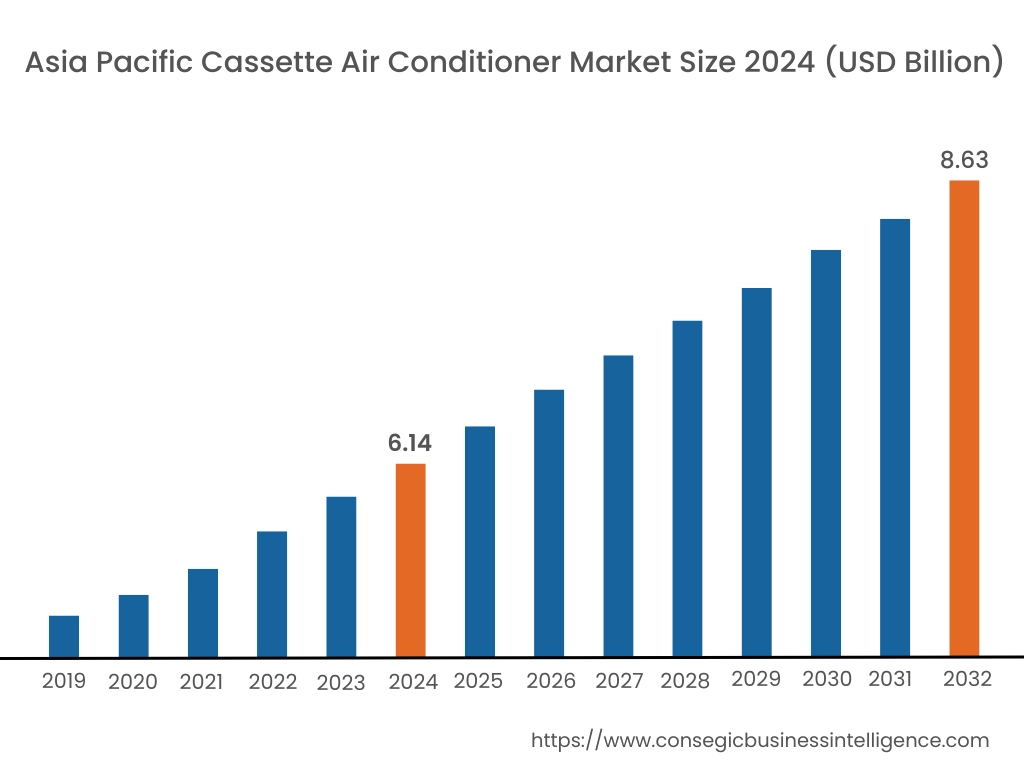
Asia Pacific region was valued at USD 6.14 Billion in 2024. Moreover, it is projected to grow by USD 6.29 Billion in 2025 and reach over USD 8.63 Billion by 2032. Out of this, China accounted for the maximum revenue share of 44.3%. The region is undergoing rapid growth in the cassette air conditioner industry, owing to increasing urbanization, infrastructure development, and the growing number of commercial buildings in key economies. China, India, Japan, and South Korea are witnessing the mass installation of cassette units at business parks, hospitals, and mid-scale retail stores. Local analysis suggests that the increasing desire for unobtrusive ceiling-mounted systems and climate flexibility are key drivers for adoption. Affordable models' availability and better distribution networks also promote strong sales. As energy labeling programs and smart building projects grow, producers of efficient and responsive cooling technologies are well-placed to take advantage of the immense cassette air conditioner market opportunity in the region.
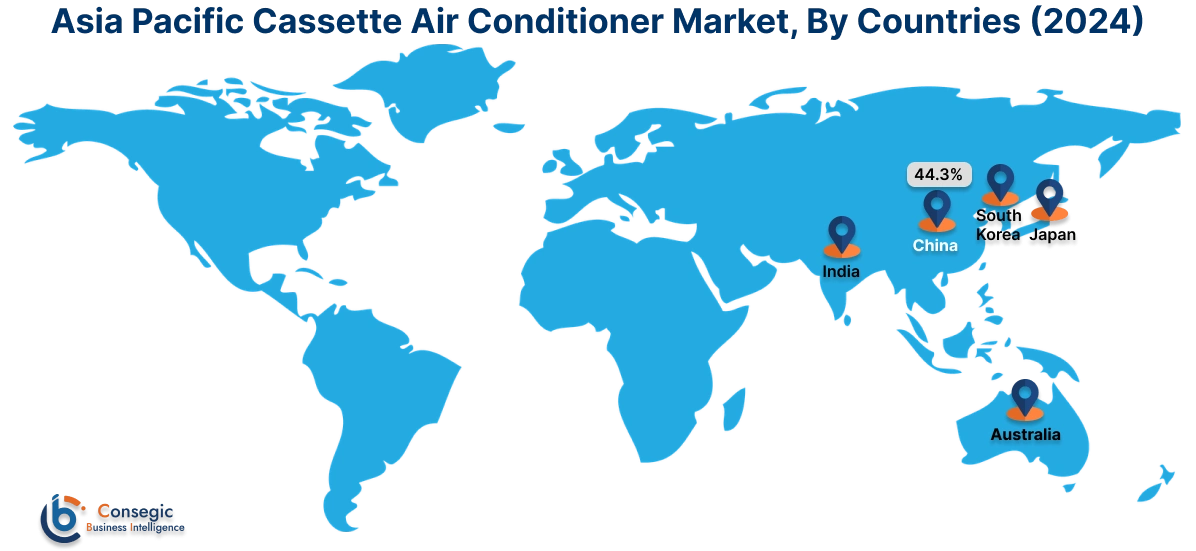
North America is estimated to reach over USD 7.54 Billion by 2032 from a value of USD 5.42 Billion in 2024 and is projected to grow by USD 5.55 Billion in 2025. North America continues to expand, with requirements focused on retail facilities, offices, and hospitality locations. The United States and Canada are increasingly embracing cassette systems in commercial urban developments, owing to their low-profile configuration and even air distribution. Market studies indicate a shift towards energy-efficient multi-zone systems and inverter-based products that meet the green building requirements. In addition, increased emphasis on retrofitting older commercial buildings with smaller, ceiling-mounted HVAC equipment is driving more extensive deployment. Integration with building management systems and quiet operation requirements are also driving product innovation within the region.
Europe offers a mature and regulation-fostered market where adoption is closely tied to space optimization within commercial and mixed-use buildings. Germany, France, Italy, and the UK are some of the countries with intense use of cassette systems in retail chains, schools, and public buildings. Market research indicates that EU's stringent directives on energy efficiency and building emissions are promoting the shift away from conventional ducted systems to zoned cooling technology. In addition, growing refurbishment of older and historic buildings without ductwork generates steady need for cassette configurations that integrate with suspended ceilings and modular interiors.
Latin America is slowly building its take-up of cassette air conditioning systems, especially in commercial centers throughout Brazil, Mexico, and Colombia. Although split systems continue to predominate in domestic applications, cassette units are finding increasing acceptance in offices, display rooms, and hospitals because of their visual acceptability and zoning features. Industry analysis indicates that as mid-range commercial building growth speeds up, there is increased concern regarding space-efficient air distribution and improved indoor comfort. Yet economic instability and local manufacturing limitations could limit deeper penetration without encouraging policy or subsidy environments.
The Middle East and Africa market is experiencing a growing need for cassette air conditioners, mainly in the hospitality, retail, and educational markets. In the UAE, Saudi Arabia, and South Africa, climate control is a priority, and the preference is for cassette systems due to their low noise levels, flexibility in design, and even distribution of air in high-traffic facilities. Analysis indicates that adoption is spurred by increasing tourism infrastructure, smart city projects, and contemporary office buildings. Demand is especially high in large indoor spaces where traditional systems lack aesthetics and coverage. Sustainable growth in the region over the long term is based on increased access to energy-efficient technologies and enhanced local after-sales support.
Top Key Players & Market Share Insights:
The cassette air conditioner market is highly competitive with major players providing products and services to the national and international markets. Key players are adopting several strategies in research and development (R&D), product innovation, and end-user launches to hold a strong position in the global cassette air conditioner market. Key players in the cassette air conditioner industry include -
- Daikin Industries Ltd. (Japan)
- Mitsubishi Electric Corporation (Japan)
- Panasonic Corporation (Japan)
- Haier Group Corporation (China)
- Midea Group Co., Ltd. (China)
- LG Electronics Inc. (South Korea)
- Samsung Electronics Co., Ltd. (South Korea)
- Fujitsu General Limited (Japan)
- Hitachi, Ltd. (Japan)
- Toshiba Corporation (Japan)
Recent Industry Developments :
Product Launches:
- In February 2024, Fujitsu unveiled two updated product ranges of R32 air conditioners. This included the R32 Ceiling Console range and the R32 Circular Flow Cassette range. The upgraded Ceiling Console consists of nine outdoor models ranging from 5.0kW to 13.0kW cooling capacity, while the Circular Flow Cassette provides 360-degree airflow for retail spaces and offices.
Cassette Air Conditioner Market Report Insights:
| Report Attributes | Report Details |
| Study Timeline | 2019-2032 |
| Market Size in 2032 | USD 25.60 Billion |
| CAGR (2025-2032) | 4.2% |
| By Product Type |
|
| By Mounting Type |
|
| By Capacity |
|
| By Application |
|
| By Region |
|
| Key Players |
|
| North America | U.S. Canada Mexico |
| Europe | U.K. Germany France Spain Italy Russia Benelux Rest of Europe |
| APAC | China South Korea Japan India Australia ASEAN Rest of Asia-Pacific |
| Middle East and Africa | GCC Turkey South Africa Rest of MEA |
| LATAM | Brazil Argentina Chile Rest of LATAM |
| Report Coverage |
|
Key Questions Answered in the Report
How big is the Cassette Air Conditioner Market? +
Cassette Air Conditioner Market size is estimated to reach over USD 25.60 Billion by 2032 from a value of USD 18.45 Billion in 2024 and is projected to grow by USD 18.89 Billion in 2025, growing at a CAGR of 4.2% from 2025 to 2032.
What specific segmentation details are covered in the Cassette Air Conditioner Market report? +
The Cassette Air Conditioner market report includes specific segmentation details for product type, mounting type, capacity and application.
What are the applications of the Cassette Air Conditioner Market? +
The applications of the Cassette Air Conditioner Market are residential, commercial, industrial and institutional.
Who are the major players in the Cassette Air Conditioner Market? +
The key participants in the Cassette Air Conditioner market are Mitsubishi Electric Corporation (Japan), Daikin Industries, Ltd. (Japan), LG Electronics Inc. (South Korea), Samsung Electronics Co., Ltd. (South Korea), Fujitsu General Limited (Japan), Hitachi, Ltd. (Japan), Toshiba Corporation (Japan), Panasonic Corporation (Japan), Haier Group Corporation (China) and Midea Group Co., Ltd. (China).
